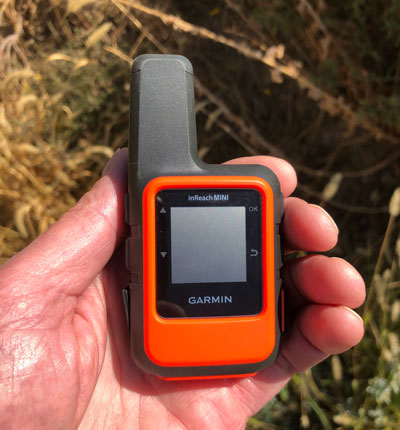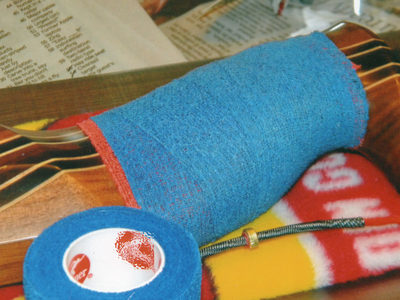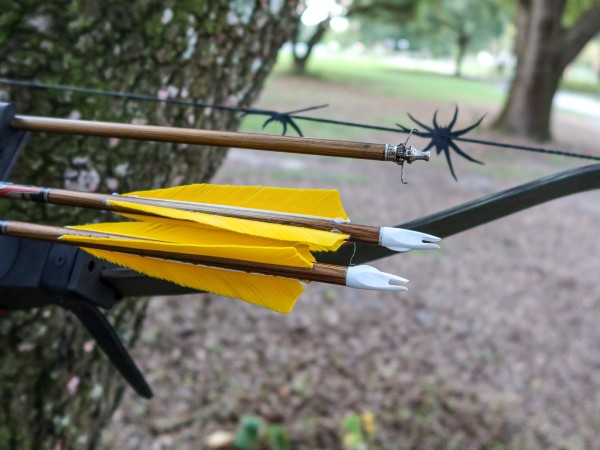As bowhunters, we spend a lot of time in the woods, forests, and hills alone, often times many miles from home…or from help should something happen. We have all heard stories of hunters being lost, hurt, or killed in the wilds every year. I have a friend who fell out of a tree stand a few years back, the results of which broke his pelvis, fractured several ribs, and punctured his colon. He laid there in agony for a long time…overnight, if I remember correctly. His cell phone was in his truck some ways away. He had almost given up having someone find him, and he somehow crawled his way back to his truck and was able to make one phone call before passing out. He almost died, which should make every one of you shudder to think you may find yourself in such a dire situation. The bottom line is we all need to think about safety when we venture afield.
On every hunt I carry a pack with not only food and water, but also gear that I hope I never have to use. Even hunting elk in my usual area, I always carry enough gear for an uncomfortable, but survivable, night or two away from base camp. Thrice in the last 20 years I have had to resort to making do overnight miles from camp in dark, cold mountains.
In my hunting pack I have lots of items: a water container, food, emergency and first aid kit, water purifier, LED headlamp, tarp for shelter, small lightweight poncho, compass, map if in new country, and fire starter items. This is just a bare list; the pack also contains many other items that I deem essential to the area I hunt.
Many years ago, when I was much younger (bulletproof, my wife reminds me!), I would simply go out with nothing: no food, water, and wearing jeans. I remember very vividly getting caught in a beautiful September thundershower late one afternoon that soaked me to my soul. By the time I got back to camp after dark I was so cold from the rain and wind that it was all I could do to take off my wet clothes and start a fire. That was a wake-up call, and I have never since left camp without a day pack with at least minimum survival gear.
Today, we have the blessing (curse, most times) of the ubiquitous cell phone, which normally can hit a cell tower in all but the most remote areas. It’s funny to think that a Smartphone today can bring you news, weather information, check your stock portfolio, allow you to post on social media, and…actually make a phone call! They are minicomputers that fit in our pockets, but with the added convenience that you can get a call out in an emergency from most places.
Now let’s talk about hunting in remote areas, like being dropped off somewhere in Alaska, Canada, or, as my case last week, hiking for days, miles deep into a wilderness area hunting mountain goats. This is where better gear is needed, especially as we get older. Our youthful elasticity, balance, and abilities slowly erode as each year passes by.
For starters, your basic safety gear is necessary. Add high quality clothing designed for both comfortable and extreme weather conditions. Snow, rain, and lightning storms are all regular occurrences in the Mountain West, as well as in almost every remote area. Some people may laugh, but trekking poles are a huge safety factor when climbing scree-strewn mountain peaks with a heavy pack, as well as descending the same treacherous terrain. They are like having an extra pair of limbs that can steady your stride, aid balance, and test the ground where your next foot will fall. They also add a level of safety and, most importantly, confidence in being able to stay on your feet when they start sliding down a steep mountainside.
Your cell phone is also an important safety item…as long as you have cell service. I had a friend fly me around my goat area several weeks ago so I could scout, shoot photos, find the easiest way to get to where I wanted to hunt, and check for cell service, which was strong…up high. What I found out on my first solo trip in was that there was zero cell reception, even on a 9,400 peak. If I were to break a leg, or have some other debilitating event, I would not be able to get help, and who knows if and when I could be found…a most uncomfortable feeling.
 That is why I have added what I consider the most important safety item to my gear bag: a Garmin inReach satellite communicator with GPS and messaging ability. I hesitated to buy another gizmo, but Don Thomas, as well as a few other close friends, convinced me that this was the most important piece of gear they carry on such remote hunting, fishing, and excursion trips.
That is why I have added what I consider the most important safety item to my gear bag: a Garmin inReach satellite communicator with GPS and messaging ability. I hesitated to buy another gizmo, but Don Thomas, as well as a few other close friends, convinced me that this was the most important piece of gear they carry on such remote hunting, fishing, and excursion trips.
The inReach Mini, shown here, costs about $350, but is simple to use and affordable. First of all, it uses the Iridium satellite system to allow you to send pre-recorded texts, manually type 130-character messages, track your movements, and send an SOS to the GEOS International Emergency Rescue Coordination Center to request extraction from anywhere in the world, at any time. It is lightweight, and when synced to your Smartphone, you can send text messages directly from your phone through the Iridium satellite system to anyone in your Contacts that you set up on their web site.
The one caveat; you need to purchase a service plan from Garmin. There are different plans, each with the option of paying a lower annual fee or paying a little higher fee by the month. For the basic emergency plan, which I purchased ($17.95 a month plus taxes), you get unlimited pre-recorded messages, 10 other text messages, and for about $18 a year, an insurance policy that will cover all expenses for an extraction/recovery up to $100,000 a year. That is a small price to pay if you realize that a rescue from remote areas can easily top $25,000 locally. And, you can cancel service for those months you don’t need it and start back up when you do.
There are other satellite communicators out there, like SPOT, that are cheaper, but after listening to several people, as well as a hunter at REI, I chose the inReach because it has better service in more areas. As in all things, quality is important.
So, as you venture out this fall, and every time you step out into the great unknown, think safety. Whatever you decide you need, make sure you have it on you when you sally forth into the out-of-doors. If you never have to use it, all the better; however, if and when you have a major medical/physical issue when away from any help, you will be glad you carried a little piece of insurance with you.
Be safe out there!







I’ve had an inReach device for the last three years. I keep the subscription in place constantly. I never want to push that SOS button and have an “Oh ——!” moment.
This is a very good article, thank you for writing it.
> “This is where better gear is needed, especially as we get older. Our youthful elasticity, balance, and abilities slowly erode as each year passes by.”
No arguments about getting older, but from what I’ve seen on Alaska State Troopers and Rescue 911 reruns is that a lot of young people over-estimate their youthfully given abilities, as the majority of injuries or lost situations were from inexperienced, under trained, under-equipped or overly playful young people.
And older, more experienced adventurers get into less trouble, it seems, even when they are out in the wilderness, maybe because they consider themselves to be more fragile, which from the injuries I’ve seen… all people are fragile out there. Wilderness is very very big, we are very small in comparison.
Just an observation from those shows. Nature seems to be a great equalizer, no matter the age. So be rightly prepared and trained, and cautious, even if you’re young.
Do not….. I repeat: DO NOT BUY SPOT SATTELITE BEACONS.
Just do a google search of the companies bad business practices and you will be turned off forever. They are simply inferior to InReach.
Personal Long story short: you sign up for $100 for one year, fine print says they will re-sign you up for double the price and there are no refunds, with a ten-day “opt-out” window each year.
The area I hunt is only about six miles from my house and covers about 600 acres. Not far away at all but, no cell service. I purchased a Delorme inreach SE (Garmin bought them out) a while back and like the tracking features on it. My kids also know that where my truck is parked indicates what area I am in so that narrows down any search that may be needed.
Just picked up an inReach® mini for the very reason you describe. Getting older, 66, and it helps with peace of mind for the family should I need help. In the arts I hunt in Colorado, one ridge line I might have cell service but drop down or go over to the next ridge and that is lost. Cell phone technology is wonderful but, it’s not the end all for part of your survival gear no mater what location you choose to be in.